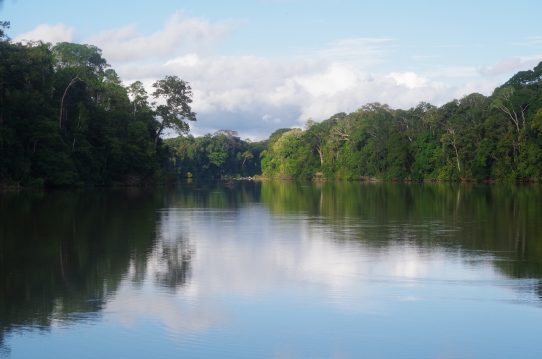Ancient Human Disturbances May Alter Understanding of Amazon
Research Published in Proceedings
of the National Academy of Sciences
MELBOURNE, FLA. — Pre-European human populations of the Amazon Basin may have affected our contemporary understanding of the forest’s structure and composition, and thus our calculations of its impact on carbon dioxide remediation, according to new findings published this month in the prestigious Proceedings of the National Academy of Sciences.
Researchers at Florida Institute of Technology, the University of Amsterdam, the University of Miami, and Wake Forest University report that forest plots in the Amazon Basin are primarily located in areas with a high probability of ancient human activity.
Our current understanding of the Amazon rainforest comes from a small network of fewer than 1,000 pieces of forest land spread out across the nearly 2.3-million-square-mile basin. Scientists have inventoried biodiversity and have been measuring how much and how fast Amazonian forests can absorb carbon dioxide from the atmosphere with the assumption that the plots were in their most pure state.
But if these plots are likely to have been disturbed by ancient people, which is what the new study implies, how much and how fast untouched Amazon forest can absorb carbon dioxide may not be completely accurate. Given the very long lifespan of some Amazonian trees, with some living for more than 400 years, many forest plot sites may still be recovering from past human disturbances. If so, these sites are growing faster than mature forests and may exaggerate the amount of carbon that can be absorbed by the forest as a whole.
“We have sampled less than 0.0005 percent of the Amazon Basin, and all that we know about its ecology comes from this limited forest plot network,” said Crystal McMichael, the lead author and professor at the University of Amsterdam and a former research scientist at Florida Tech. “We may need to reevaluate what we know about biodiversity and carbon budgets given that many of these forests may still be recovering from past disturbance.”
It is well known that the Amazon’s pre-European population actively modified and transformed the forest before their population collapse around AD 1491. But the impact of ancient human activities has been largely neglected in many of the previous highly influential studies using Amazonian forest plots.
These new findings may necessitate a recalibration of previous readings of the benefits of the forests on carbon dioxide remediation.
“If forest inventory plots are located in areas likely occupied by past human populations, then we must look at the existing estimates of the Amazon forests to offset our release of carbon dioxide as being overly optimistic,” said Frazer Matthews-Bird, a biological sciences postdoctoral research associate at Florida Tech.
Find the full paper here.
###





